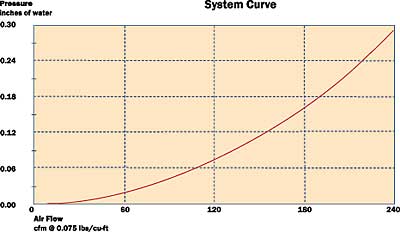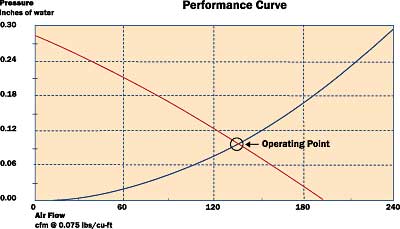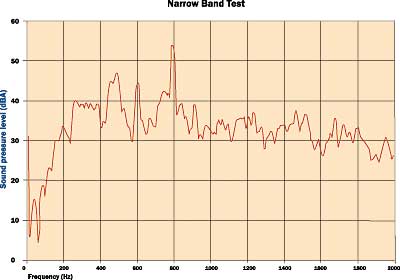There are three basics to creating low-noise axial fan applications:
- airflow path design
- initial fan design
- analysis and correction of specific acoustical responses in the physical model
Each is important and contributes to the overall sound levels of the program.
 |
Figure 1. Representative flow-versus-pressure characteristic of system air path.A flow-versus-pressure characteristic of the system air path is determined first (Figure 1). It is common to find areas in the system that, due to air direction changes or reduced cross sections, increase airflow resistance. Minimizing losses not only will ultimately reduce noise but also reduce power. Another issue is the optimization of the amount of airflow needed. The evaluation should include any fan-to-system interference problems, such as a wall directly upstream or downstream of the fan. During this process it is important to conceptualize the number and size of fans needed. These choices help initiate the next step.
 |
Figure 2. Representative data used to determine optimal fan performance.With an optimized system design the flow-versus-pressure point (operating point) is determined and used to design a fan (Figure 2). While it is possible to select a fan from a product catalog, the best approach is to design a new one that will operate at or near its peak efficiency point. The design process allows the choice of a fan operating speed that can be reduced for any given diameter by increasing characteristics, like blade pitch and blade geometry. Reduced operating speed correlates to low noise. Once a design is completed, a model that can achieve the desired operating point can be built.
The final step is confirming that the proper flow is achieved and then analyzing the fan’s noise signature on a decibel-versus-frequency graph (Figure 3). This review allows the designer to find and correct noise “spikes”, such as blade pass, imbalance and natural frequencies. While this last step is often overlooked, it can help greatly, especially if modification can be made to the design that was created in step two above.
 |
Figure 3. Representative axial fan sound signature.These three basic steps are essential to making major reductions in noise levels.





